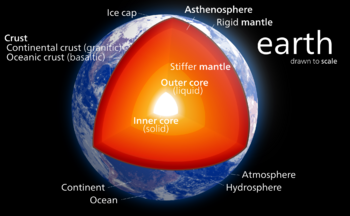Earth:Mesosphere (mantle)

In geology, the mesosphere refers to the part of the Earth's mantle below the lithosphere and the asthenosphere, but above the outer core. The upper boundary is defined by the sharp increase in seismic wave velocities and density at a depth of 660 kilometers (410 mi).[1] At a depth of 660 km, ringwoodite (γ-(Mg,Fe)2SiO4) decomposes into Mg-Si perovskite and magnesiowüstite.[1] This reaction marks the boundary between upper mantle and lower mantle. This measurement is estimated from seismic data and high-pressure laboratory experiments.
The base of the mesosphere includes the D″ zone which lies just above the mantle–core boundary at approximately 2,700 to 2,890 km (1,678 to 1,796 mi). The base of the lower mantle is at about 2700 km.[1]
"Mesosphere" (not to be confused with mesosphere, a layer of the atmosphere) is derived from "mesospheric shell", coined by Reginald Aldworth Daly, a Harvard University geology professor. In the pre-plate tectonics era, Daly (1940) inferred that the outer Earth consisted of three spherical layers: lithosphere (including the crust), asthenosphere, and mesospheric shell.[2] Daly’s hypothetical depths to the lithosphere–asthenosphere boundary ranged from 80 to 100 km (50 to 62 mi), and the top of the mesospheric shell (base of the asthenosphere) were from 200 to 480 km (124 to 298 mi). Thus, Daly’s asthenosphere was inferred to be 120 to 400 km (75 to 249 mi) thick. According to Daly, the base of the solid Earth mesosphere could extend to the base of the mantle (and, thus, to the top of the core).
A derivative term, mesoplates, was introduced as a heuristic, based on a combination of "mesosphere" and "plate", for postulated reference frames in which mantle hotspots apparently exist.[citation needed]
References
- ↑ 1.0 1.1 1.2 Condie, Kent C. (2001). 'Mantle Plumes and Their Record in Earth History. Cambridge University Press. pp. 3–10. ISBN 0-521-01472-7.
- ↑ Daly, Reginald Aldworth (1940). Strength and Structure of the Earth. New York: Prentice Hall. https://archive.org/details/strengthstructur00daly.
